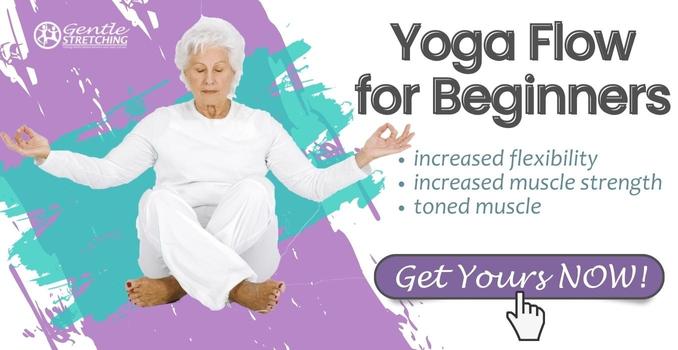
Calm the Ache with Yoga: Effective Natural Remedy for Sore Muscles
Experiencing body aches and muscle soreness is almost unavoidable in today's fast-paced lifestyle. Engaging in various activities, tasks, and responsibilities often requires significant physical effort, which can eventually lead to muscle fatigue. Consequently, many of us turn to quick fixes like supplements to reduce muscle pain. This is why exploring yoga as a natural remedy for sore muscles can be a safer and more holistic alternative to relieve pain.
However, the market is flooded with numerous options, and their safety is frequently a concern. Additionally, besides their high cost, these supplements and medications can potentially lead to undesirable side effects so it is better to try natural remedies for sore muscles.
Opting for Natural Remedies
Opting for natural remedies for sore muscles offers numerous advantages. In contrast to artificial pharmaceuticals, natural remedies frequently exhibit fewer side effects, diminishing the likelihood of adverse responses. They work harmoniously with the body's natural processes, promoting long-term wellness rather than just masking symptoms. Yoga, Epsom salt, and apple cider vinegar are some home remedies known to help with muscle-related pains.
Natural remedies for sore muscles like these are gentler and more sustainable over time, making them a preferred choice for chronic pain management. Moreover, they are often more accessible and cost-effective, allowing individuals to take control of their health with holistic, nature-inspired solutions.
The Natural Essence of Yoga
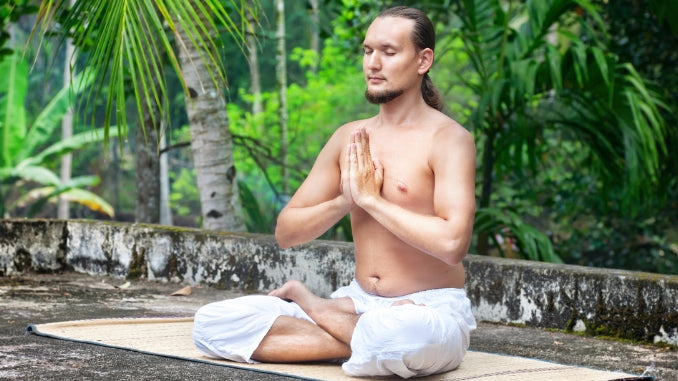 |
The natural essence of yoga lies in its profound ability to harmonize mind, body, and spirit through a holistic practice deeply rooted in ancient traditions. Yoga is a natural remedy for addressing various muscle aches and discomforts due to its gentle yet potent approach. By incorporating stretching, strengthening, and breathing techniques, yoga fosters flexibility and muscular balance, reducing muscle tension and stiffness.
Additionally, the meditative aspect of yoga promotes mindfulness and relaxation, alleviating stress-induced pains. Furthermore, yoga encourages the body's innate ability to heal itself, enhancing circulation and the flow of energy, which can accelerate muscle recovery from injuries, reduce muscle cramps, and address chronic pain. Unlike synthetic pain relievers, yoga has no harmful side effects, making it a safe and sustainable option for those seeking long-term pain relief.
In embracing the natural essence of yoga, individuals can discover a profound sense of well-being and an effective means to alleviate and prevent various forms of physical discomfort.
Yoga for Sore Muscles
This yoga routine can effectively address post-exercise muscle soreness by promoting gentle stretching and relaxation. The combination of controlled movements and deep breathing can help release tension, increase blood flow, and improve flexibility, ultimately reducing muscle discomfort and promoting a quicker recovery after physical activity.
1. Mindful Breathing
Begin in an upright sitting position with your legs crossed in front of your body, while maintaining good alignment with your head, shoulders, and hips. Place both hands on your knees and then engage your core. Fix your gaze at an unmoving focal point, or you may close your eyes as you relax your shoulders. Mindfully take controlled breathing as you bring awareness to your body and your surroundings. Perform this practice for several deep belly breaths, in through your nose and then out through your mouth.
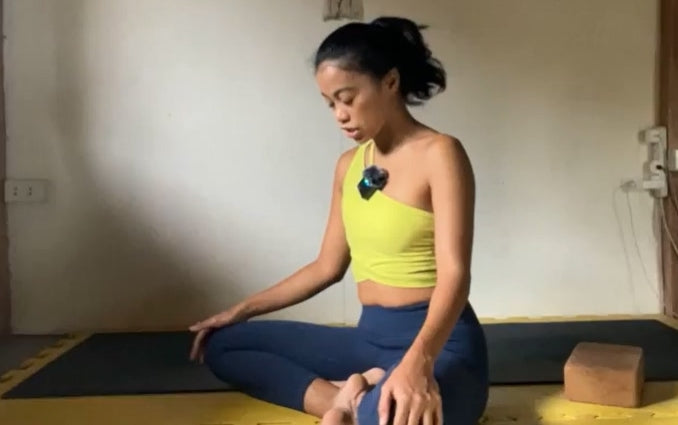 |
2. Half Circle Neck Stretch
Begin in an upright sitting position on the floor with your legs crossed in front of your body, while maintaining good alignment with your head, shoulders, and hips. Place your hands on your knees and then engage your core. Looking for a light stretch along the side of the neck, lower your chin towards your chest, then swing your head to one side, bringing your ear towards your shoulder. Reverse the movement back to the center and rotate your neck to the opposite side. Perform the movement for several repetitions, alternating directions.
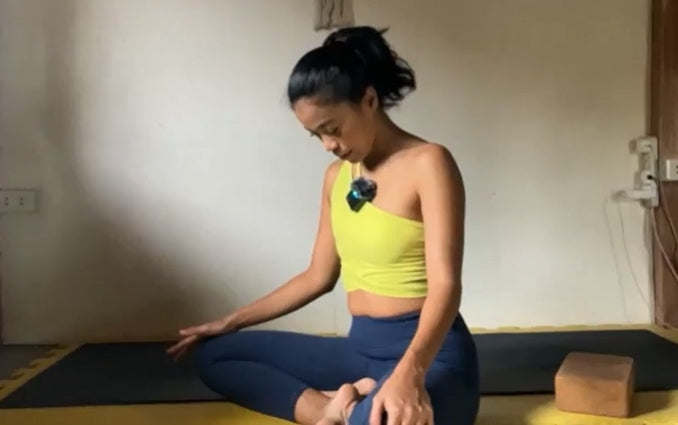 |
 |
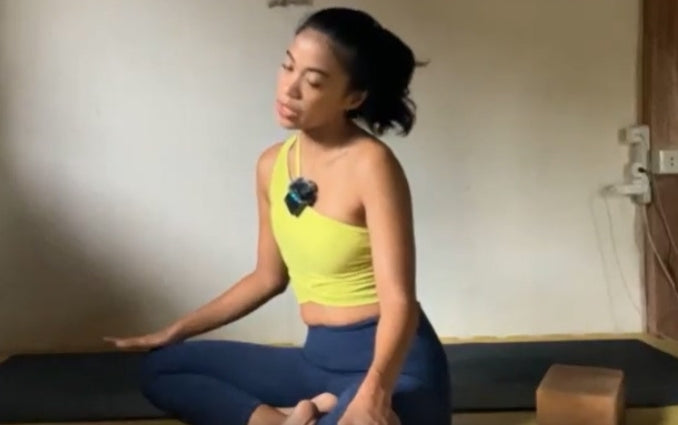 |
3. Arms Overhead Stretch
Begin in an upright sitting position on the floor with your legs crossed in front of your body, while maintaining good alignment with your head, shoulders, and hips. Engage your core. Place one hand at your side for support, then bring the opposite arm overhead as you bend your upper body to the side. Hold the position for a couple of deep belly breaths. Slowly return to the neutral starting position and repeat the movement on the opposite side.
 |
4. Seated Spinal Twist
Begin in an upright sitting position on the floor, with your legs crossed, while maintaining good alignment with your head, shoulders, and hips. Place one hand on your opposite knee. Engage your core and then twist your upper body to one side, reaching back with your other hand for a light stretch. Hold the position for several deep belly breaths, in through your nose and then out through your mouth. Return to a neutral position as you raise both arms overhead. Repeat the movement in the opposite direction.
 |
5. Thread and Needle
Begin in a 4-point position with your hands beneath your shoulders and your knees under your hips. Engage your core. Extend one arm towards the ceiling, and slide the same hand under your supporting arm with your palm facing upward. Lower your shoulder to the floor and rest the side of your head on the floor. Hold this position for several deep belly breaths, in through your nose and then out through your mouth. , Return to the starting position and repeat the movement on the opposite side.
In addition, depending on your comfort level, you can either keep your opposite arm extended overhead as you rest the side of your head on the floor or reach it behind your back for added stretch.
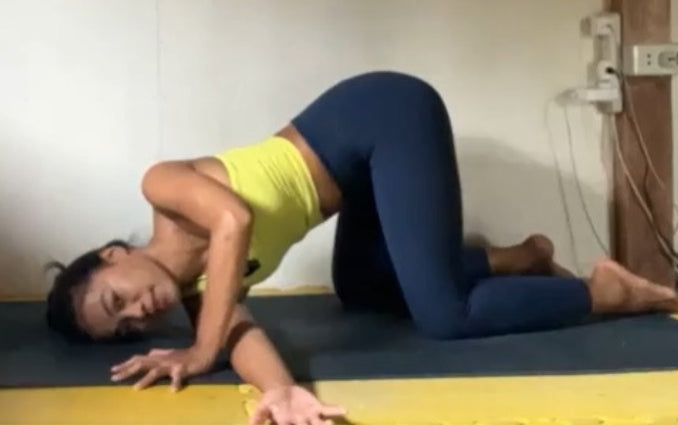 |
 |
6. Figure 4
Lie on your back with your knees bent and your feet flat on the floor. Cross one ankle over the opposite knee and raise both legs, holding your lower leg with both hands. Pull your knee closer to your chest to intensify the stretch. Hold this position for 10 seconds. Take a couple of deep belly breaths in through your nose and then out through your mouth. Relax, return to the starting position, and then repeat the movement on the opposite side.
 |
7. Supported Full Body Stretch
Lie on your back on the floor, while maintaining good alignment with your head, shoulders, hips, and legs. Place a yoga block or a pillow under your lower back, just above the glutes, for support. Engage your core and then bring your arms overhead, taking a big reach as you stretch your legs long. Hold this position for several deep belly breaths, in through your nose and then out through your mouth.
Furthermore, depending on the comfort level, you may bend both knees and push from your heels to lift your hips into a Bridge Pose.
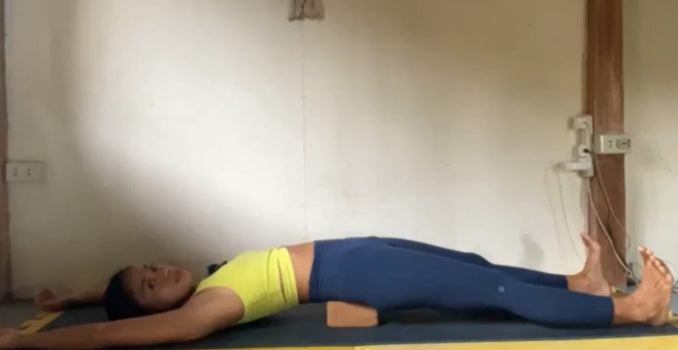 |
Variation 1- Single Knee to Chest
Lie on your back on the floor, while maintaining good alignment with your head, shoulders, hips, and legs. Place a yoga block or a pillow under your lower back, just above your glutes, for support. Tighten your core and bring one knee up towards your chest, using your hands to pull your knee closer to your body. Hold this position for several deep belly breaths, in through your nose and out through your mouth. Relax and then return to the starting position. Repeat the movement on the opposite leg.
 |
8. Happy Baby
Lie on your back on the floor with your knees bent and feet flat on the floor, relaxing your upper body. Lift your legs to bring your knee towards your shoulders and then hold the outsides of your feet with your hands. Hold the position for several deep belly breaths, in through your nose and then out through your mouth.
Moreover, to intensify this exercise, you can gently rock your lower spine from side to side.
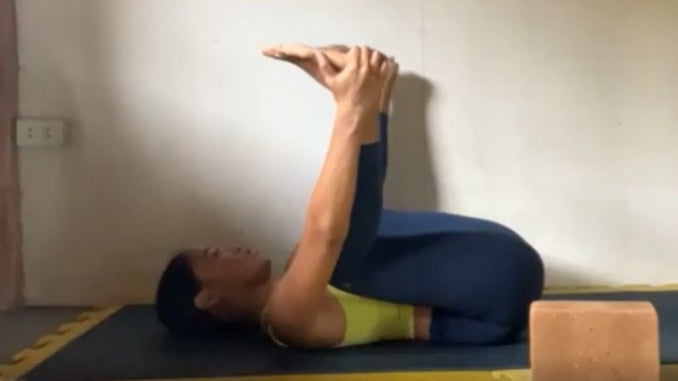 |
9. Low Lunge
Begin in a 4-point position with your hands beneath your shoulders and your knees under your hips. Take a big step forward with one foot and place your hands on your bent knee, keeping your toes pointing straight ahead. Maintain good alignment with your head, shoulders, and then hips. Tighten your abdominal area and shift your hips forward. Hold this position for several deep belly breaths, in through your nose and then out through your mouth. Relax and return to the starting position. Repeat the movement on the opposite side.
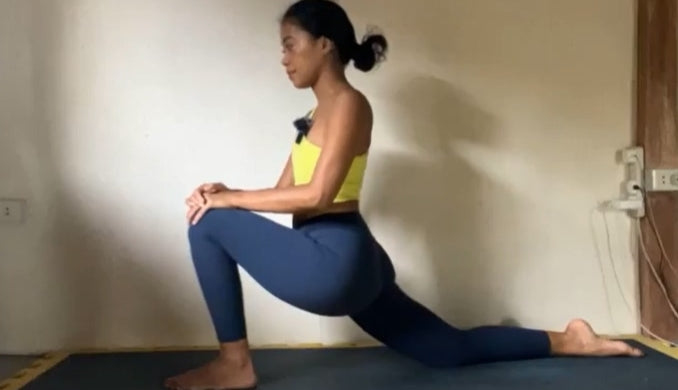 |
10. Half Split
From the Low Lunge position, push your hips back to straighten your front leg, and plant your heel on the floor while keeping your hands anchored to the floor for support. Hold this position for a few belly breaths, in through your nose and then out through your mouth. Then relax and return to the starting position. Repeat the movement on the opposite side.
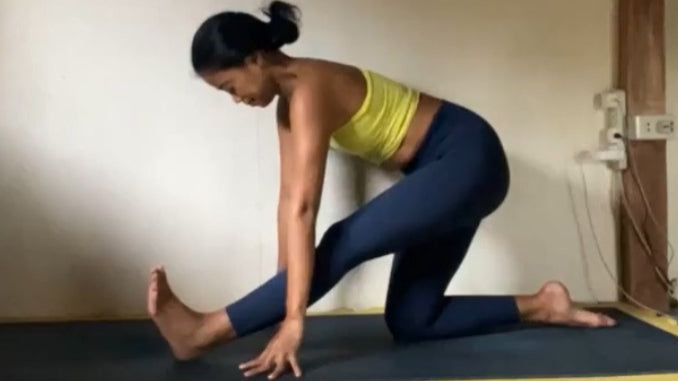 |
11. Sphynx Pose
Lie on your stomach with your feet shoulder-width apart, while maintaining good alignment with your head, shoulders, hips, and legs. Bring your elbows beneath your shoulders, spreading your fingers wide for a good base of support. Press and arch your back, using your glutes and back muscle strength. To intensify the stretch, move your forearms closer toward you and slowly pull yourself forward to open up your chest. Keep your hips anchored into the mat. Hold this position for a couple of breaths, in through your nose and out through your mouth. Relax and then return to the starting position.
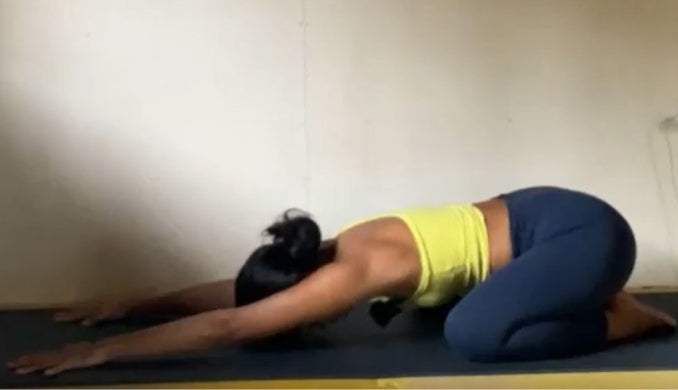 |
12. Heart Opener
From the Sphynx Pose, place your hand behind the back and interlace your fingers. Engage your core. Then pull your shoulders back, lifting your head and chest. Hold this position for several deep belly breaths, in through your nose and then out through your mouth.
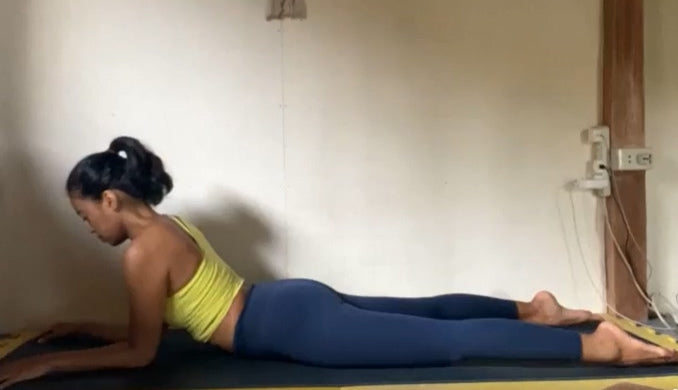 |
13. Child’s Pose
Begin in a 4-point position with your hands beneath your shoulders and your knees under your hips. Then tighten your abdominal area and widen your knees. After that, shift your hips back to your feet while extending both arms to relax your midback area for a light stretch. Hold this position for several deep belly breaths in through your nose and then out through your mouth. Return to the starting position.
In addition, to make the pose easier, use a yoga block, bolster, or pillow to support your upper and lower body.
 |
14. Eagle Arms Pose
Begin in an upright kneeling position, while maintaining good alignment with your head, shoulders, and hips. Shift your hips back to rest your seat on your feet. Cross your arms in front of your body by placing your left arm over the other at shoulder height, then wrapping at the elbows and wrists. Inhale as you bring your arms up and gaze toward the middle of your lower arm. Close your eyes, relax, and hold this position for a few deep belly breaths. Exhale as you unwrap your hands. Repeat the movement on the opposite side.
Moreover, to make this movement more challenging, you can slightly arch your back and lift your arms higher towards the ceiling.
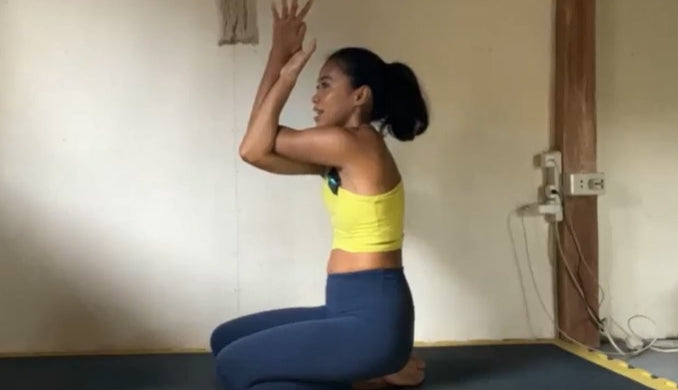 |
15. Forward Bend Heart Opener
From the end position of the Eagle’s Arms Pose, clasp your hands behind the back. Then fold your upper body forward, resting your forehead on the floor. Then engage your core and lift your joined hands away from your body. Hold this position for several deep belly breaths, in through your nose and then out through your mouth. Relax and then return to the starting position.
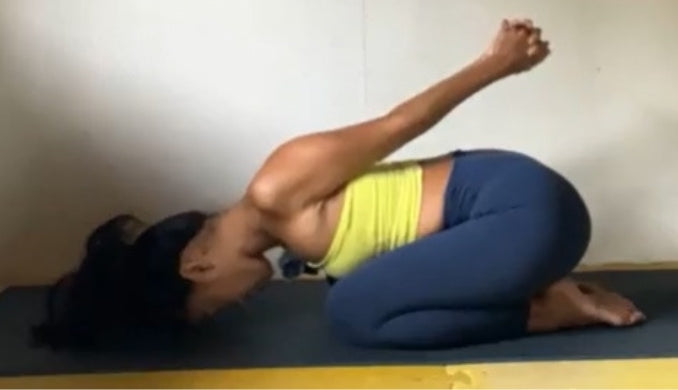 |
Conclusion
In conclusion, embracing natural remedies for sore muscles like yoga provides a holistic approach to wellness, aligning with the body's innate healing abilities. In today's fast-paced world, where muscle soreness and discomfort are common, prioritizing long-term well-being over quick fixes is essential. Yoga, deeply rooted in ancient traditions, offers an effective and gentle solution to address aching muscles, resolve joint pain, and reduce inflammation.
Yoga enhances flexibility, balances muscles, and promotes mental relaxation and mindfulness, alleviating stress-related pain. Unlike synthetic medications, it supports the body's natural healing processes without harmful side effects. By exploring the best natural remedies for sore muscle, individuals can find a path to profound well-being and sustainable relief from physical discomfort, empowering them to take control of their health through holistic, nature-inspired solutions.
Yoga Flow for Beginners is truly the best way to build your confidence, stay safe, and learn some simple, gentle yoga routines designed to introduce to increase your flexibility and strength, all in the comfort of your own home. Check out now!

